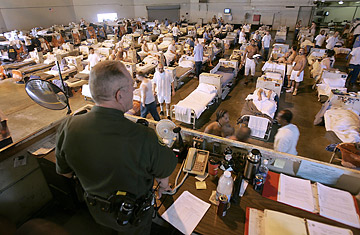
An officer oversees inmates living in a makeshift dormitory filled to more than double its capacity at the Deuel Vocational Institution near Tracy, California.
California is often on the cutting edge of national trends — and so it is now with the "ugly bed." That is prison lingo for double and triple bunks that are jammed into gymnasiums and dayrooms because there is nowhere else to put the inmates. It is an inhumane and dangerous way to house prisoners, but it is one that has become all too common in California's jam-packed correctional facilities.
It has been nearly four years since Gov. Arnold Schwarzenegger declared a "Prison Overcrowding State of Emergency," warning that conditions in the state's 33 adult prisons posed a serious risk to inmates and staff. But the overcrowding has continued.
And while California's legislature has dithered, the federal courts have stepped in, ordering the state to bring down its prison population. On Monday, however, the Supreme Court accepted an appeal in this California prisons-condition case. It is an ominous development, one that could make prisons far worse in all 50 states.
California's correctional facilities are among the nation's most overcrowded. The driving force has been the state's harsh and at times bizarre criminal laws and parole practices. Under the state's notorious three-strikes-and-you're-out law, criminals can be sent away for life for even minor, non-violent crimes — including shoplifting. Not surprisingly, then, the prison population has soared over the past few decades, from about 20,000 in the early 1970s to past 160,000 in recent years.
The results have been disastrous, with Schwarzenegger's state-of-emergency declaration painting a grim picture. Because of the overcrowding, it was difficult for the guards to monitor prisoners and to prevent violence from breaking out. There were frequent power outages. And the sewage systems were overtaxed, creating a risk of disease. "Immediate action is necessary," the governor warned, "to prevent death and harm."
That action never came — at least not on the scale that was needed — but the death and harm did. Prisoners have been dying and suffering injuries at alarming rates. Last summer, 250 inmates were injured in a riot at a state prison in Chino. The facility was built to hold 3,160 inmates, but roughly twice that number had been crammed into it.
Last summer, a special three-judge federal court intervened. It ruled that California's prison medical system — which a judge had declared to be responsible for one inmate death a week — violated the Eighth Amendment's ban on cruel and unusual punishment.The court ordered the state to cap its prison population at 137% of capacity, and to release about 40,000 inmates — roughly a quarter of the total population — over two years.
It was a good and important ruling, which promised to begin making California's increasingly barbaric prisons safer and more civilized. But the Supreme Court's decision this week throws that potential bit of progress into doubt, and not just for California.
The United States is a country that likes to put people behind bars. It has less than 5% of the world's population, but almost one-quarter of the world's prisoners. One in every 100 American adults is behind bars, the highest incarceration rate in the world; between 1972 and 2008, the number of state prisoners soared by 708%. Making matters worse, this rush to incarcerate has not been matched by an equal commitment to funding.
The Supreme Court, which is likely to schedule arguments in the case during its next term, starting in the fall, could end up upholding the lower-court ruling from California, but there is good reason to think it might not. The court's conservative majority has taken an unduly narrow view of the Eighth Amendment in recent years. And it could use the case to rewrite prison conditions law and to make it extremely difficult for judges to bring down prison populations, even when they reach dangerous levels.
That would be unfortunate. Overincarceration is not only inhumane — it is terrible correctional policy. Crowded prisons are more likely to have riots and inmate-on-inmate violence, including sexual assaults. Inmates in jam-packed prisons also have less opportunity to improve themselves, and are more likely to come out of prison unrehabilitated and hardened. That is bad news for law-abiding citizens, since most prisoners are eventually released back into society.
Some people argue that governors and legislatures are the branches of government that should decide how prisons are run — and for the most part, they are right. But when those branches repeatedly fail to ensure that prisons are run in a minimally adequate way, judges have to have the authority to step in and enforce the Constitution.
Cohen, a lawyer, is a former TIME writer and a former member of the New York Times editorial board.
